| ________________
CM . . .
. Volume XXIII Number 5. . . .October 7, 2016

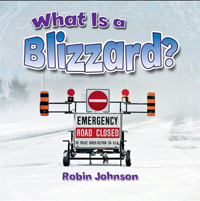 |
What is a Blizzard? (Severe Weather Close-Up).
Robin Johnson.
St. Catharines, ON: Crabtree, 2016.
24 pp., pbk., hc., & html, $8.95 (pbk.), $22.95 (List RLB), $18.36 (School RLB).
ISBN 978-0-7787-2425-4 (pbk.), ISBN 978-0-7787-2395-0 (RLB), ISBN 978-1-4271-1748-9 (html).
Subject Heading:
Blizzards-Juvenile literature.
Grades 2-3 / Ages 7-8.
Review by Suzanne Pierson.
**** /4
|
| |
|
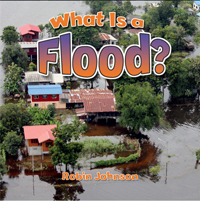 |
What is a Flood? (Severe Weather Close-Up).
Robin Johnson.
St. Catharines, ON: Crabtree, 2016.
24 pp., pbk., hc., & html, $8.95 (pbk.), $22.95 (List RLB), $18.36 (School RLB).
ISBN 978-0-7787-2427-8 (pbk.), ISBN 978-0-7787-2396-7 (RLB), ISBN 978-1-4271-1749-6 (html).
Subject Heading:
Floods-Juvenile literature.
Grades 2-3 / Ages 7-8.
Review by Suzanne Pierson.
**** /4
|
| |
|
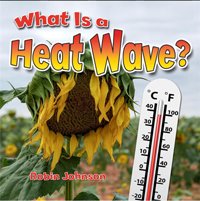 |
What is a Heat Wave? (Severe Weather Close-Up).
Robin Johnson.
St. Catharines, ON: Crabtree, 2016.
24 pp., pbk., hc., & html, $8.95 (pbk.), $22.95 (List RLB), $18.36 (School RLB).
ISBN 978-0-7787-2435-3 (pbk.), ISBN 978-0-7787-2497-4 (RLB), ISBN 978-1-4271-1750-2 (html).
Subject Heading:
Heat waves (Meteorology)-Juvenile literature.
Grades 2-3 / Ages 7-8.
Review by Suzanne Pierson.
**** /4
|
| |
|
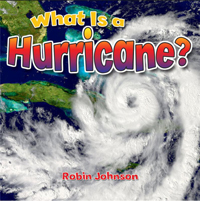 |
What is a Hurricane? (Severe Weather Close-Up).
Robin Johnson.
St. Catharines, ON: Crabtree, 2016.
24 pp., pbk., hc., & html, $8.95 (pbk.), $22.95 (List RLB), $18.36 (School RLB).
ISBN 978-0-7787-2436-0 (pbk.), ISBN 978-0-7787-2398-1 (RLB), ISBN 978-1-4271-1751-9 (html).
Subject Heading:
Hurricanes-Juvenile literature.
Grades 2-3 / Ages 7-8.
Review by Suzanne Pierson.
**** /4
|
| |
|
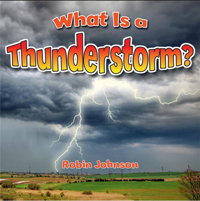 |
What is a Thunderstorm? (Severe Weather Close-Up).
Robin Johnson.
St. Catharines, ON: Crabtree, 2016.
24 pp., pbk., hc., & html, $8.95 (pbk.), $22.95 (List RLB), $18.36 (School RLB).
ISBN 978-0-7787-2437-7 (pbk.), ISBN 978-0-7787-2400-1 (RLB), ISBN 978-1-4271-1752-6 (html).
Subject Heading:
Thunderstorms-Juvenile literature.
Grades 2-3 / Ages 7-8.
Review by Suzanne Pierson.
**** /4
|
| |
|
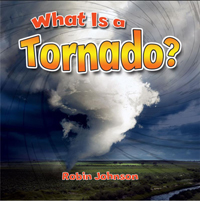 |
What is a Tornado? (Severe Weather Close-Up).
Robin Johnson.
St. Catharines, ON: Crabtree, 2016.
24 pp., pbk., hc., & html, $8.95 (pbk.), $22.95 (List RLB), $18.36 (School RLB).
ISBN 978-0-7787-2438-4 (pbk.), ISBN 978-0-7787-2423-0 (RLB), ISBN 978-1-4271-1753-3 (html).
Subject Heading:
Tornados-Juvenile literature.
Grades 2-3 / Ages 7-8.
Review by Suzanne Pierson.
**** /4
|
| |
|

excerpt:
Around the world:
Heat waves happen in many parts of the world, including the United States and Canada. These places have hot summers – but heat waves make them even hotter! In some parts of the world, long periods of high temperatures are part of the usual weather. A heat wave in one part of the world may be just normal weather in areas with hot climates. (From What is a Heat Wave?)
These books in the “Severe Weather Close-Up” series are all winners. If you need attractive and engaging material about weather for developing readers, these are well worth considering.
“Severe Weather Close-Up” looks at six different types of weather incidents. Written by the same author, Robin Johnson, all six books are filled with informative text and pictures. The books examine how meteorologists predict severe weather and how to stay safe before, during, and after severe weather events. These are excellent entry level books about blizzards, floods, heat waves, hurricanes, thunderstorms and tornados.
Each book contains a table of contents, index, glossary and a list of books and websites for further research. This series is written at a Grade 1 reading level but contains some fairly sophisticated science in very simple terms.
Thunderstorm clouds grow high into the air, where the temperature is even cooler. Freezing temperatures turn some water drops into bits of ice. Moving air causes the ice and water to bump into each other. Each time they bump together, they make electricity. Electricity builds up in the clouds until it is released as lightning. (From What is a Thunderstorm?)
Text boxes in each book highlight additional information, and “What do you Think?” boxes ask probing higher level questions. At the end of each book, there is an activity to help students explore the weather topic more deeply.
What is a Blizzard? looks at both the fun parts of a snowfall and the hazard conditions that can occur if there is too much snow accompanied with strong winds. As a concluding activity, readers are asked to prepare a list of what they need to have in a “blizzard kit” in the event that they are snowed in. They can then check their list against the list given on the following page.
What is a Flood? explains how water is a necessity of life for all living things but how too much water at one time can be life threatening. Different causes of flooding are identified, including dams that overflow or burst, high winds that drive water onto dry land, snow melt, and excessive rain fall. Students are guided to make an escape plan and make a family emergency kit.
What is a Heat Wave? identifies how important the sun is to life on Earth and also how dangerous a heat wave can be to people and animals. A “What do you Think?” box asks readers “Why is it important to use less water during a drought?” A text box reminds students “Heat waves are dangerous for animals, too! Bring your pets inside or make sure they have shady spots to rest outside. Give them plenty of cool water to drink”.
What is a Hurricane? includes some dramatic photos of hurricanes from space, and pictures of the damage caused when hurricanes make landfall. A text box with a picture of some of the damage from Hurricane Katrina explains that “In 2005, it made landfall in Louisiana with 125 mph (205 kph) winds”. Accompanying the picture is a chart of the Hurricane Wind Scale.
What do you Think?
Look at the chart on this page. Which category of hurricane did Katrina fall into on landfall?
What is a Thunderstorm? deals with one of the most common types of severe weather that young readers are likely to experience. An explanation of the dangers of lightning includes a discussion of safe and unsafe places to be during a thunderstorm. A text box reminds readers to bring your pets indoors during a thunderstorm also.
What is a Tornado? explains what to do if a tornado is approaching. Dramatic photos of funnel clouds and tornado damage make it clear that taking shelter is always a good idea. One oversight is the lack of mention of Canadian areas most prone to tornadoes. Tornado Alley in the mid United States is identified on a map, but the map doesn’t go beyond the continental US to show Canada’s most tornado prone areas in the prairies and southern Ontario and Quebec.
Each of the books in the “Severe Weather Close-Up” series uses clear text and well-chosen photos and illustrations to explain the weather concepts. One of their greatest strengths is the focus on what to do to be safe before, during and after a severe weather incident. Good planning is critical, and students are encouraged to involve their families in making emergency plans.
Whether you choose to purchase specific topics from this series, or all six books, they will be good additions to your collection.
Highly Recommended.
Suzanne Pierson is a retired teacher-librarian, currently instructing Librarianship courses at Queen’s University in Kingston, ON.

To comment
on this title or this review, send mail to cm@umanitoba.ca.
Copyright © the Manitoba Library Association. Reproduction for personal
use is permitted only if this copyright notice is maintained. Any
other reproduction is prohibited without permission.
Next Review | Table of Contents For This Issue - October 7, 2016
CM Home | Back Issues
| Search
| CM Archive
| Profiles Archive
|





